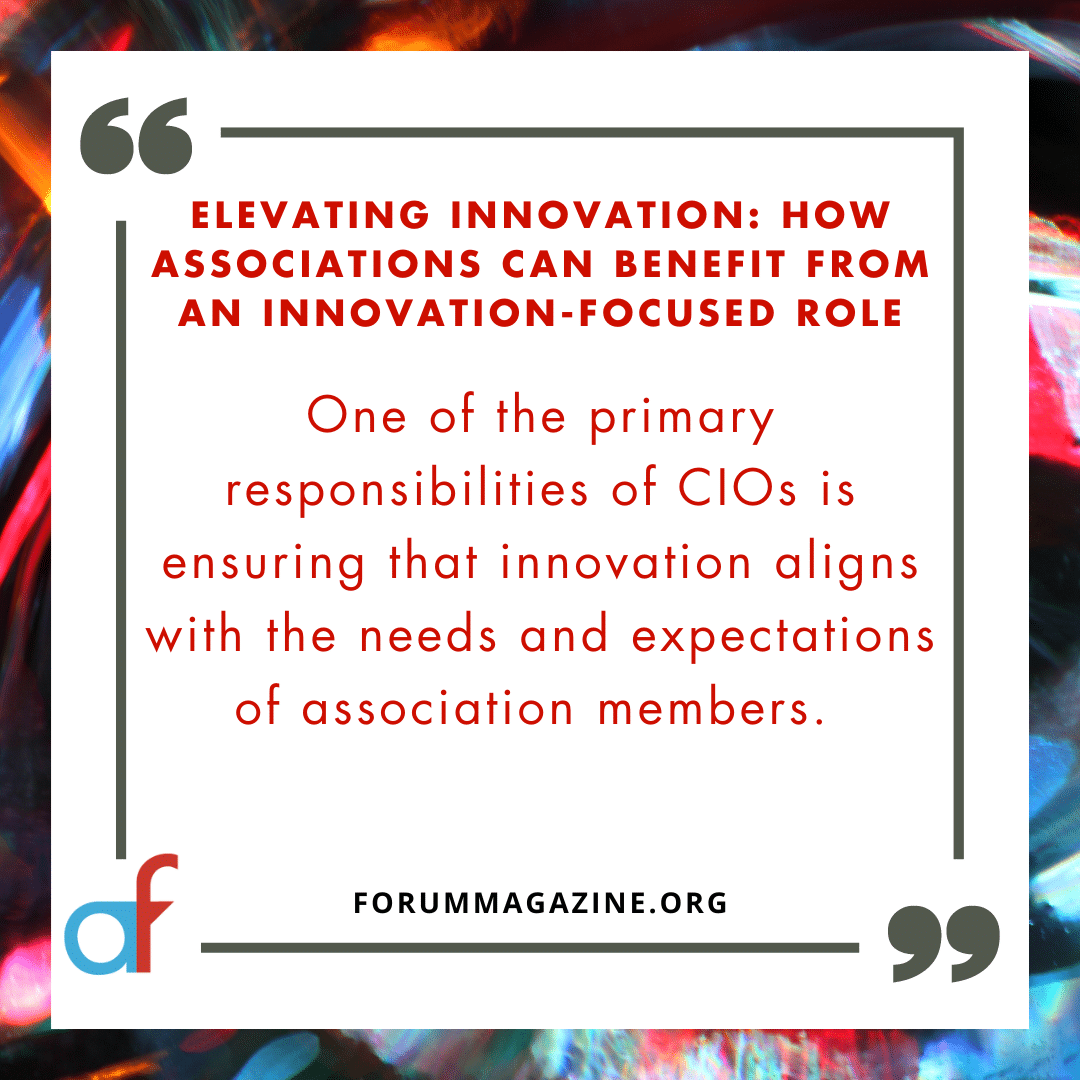How Associations Can Benefit from an Innovation-Focused Role

In the dynamic landscape of associations, the role of Chief Innovation Officers (CIOs) has emerged as a driving force for continued growth. As we steer through an era marked by technological advancements, shifting member expectations, and global challenges, the need for innovation is becoming more pressing. Three innovation officers share strategies driving meaningful change in their organizations.
The Role of Innovation Officers in Associations
Associations are no strangers to change, but the pace and nature of change now demands a fresh approach. CIOs, as visionaries, understand that innovation is about fostering a culture that embraces experimentation and adapts to evolving landscapes.
Eric O’Connor, Chief Innovation Officer at the American Association of Nurse Anesthesiology (AANA), focuses on three growth areas. “The first is identifying how to accelerate growth within the core revenue generating activities of the association, which encompasses membership, meetings, and professional development,” he said. “The second is exploring how new business opportunities outside of the traditional association model, such as partnering with start-ups, can help with growth. And the third is looking at innovation processes inside the association, like AI, to consider how we might leverage technology to change how we work.”
Exploring business opportunities outside of the traditional association model is what sparked AANA’s launch of Rm8, an innovation lab that facilitates growth in emerging start-ups and provides members an avenue to bring new healthcare product and service ideas to market. Rm8 offers expertise and opportunities for AANA’s more than 61,000 members, affiliated business leaders, and available capital. It supports members and startups by providing them with:
- Access to CRNA innovators and business owners
- Investment and partnership opportunities
- Support from AANA marketing, finance, and business experts.
“We have consistently seen solid revenue from membership, but we were interested in exploring innovative ways to grow non-dues revenue to fuel our mission of advancing nurse anesthesiology,” said O’Connor. “Rm8 has allowed us to do just that.”
Bringing a Member-Centric Approach Front and Center
One of the primary responsibilities of CIOs is ensuring that innovation aligns with the needs and expectations of association members. They act as advocates for the member experience, leveraging technology to enhance engagement, deliver personalized services, and provide deeper value.
Stephanie Moritz, Chief Customer Innovation Officer at the American Dental Association (ADA), describes her role as “customer-centric” innovation. She delivers end-to-end global solutions through transformative experiences, products, and engagement. In addition to her role, the ADA’s Business Innovation Group and Innovation Advisory Committee explore new technologies, products, and growth opportunities across the dental profession. This includes early-stage investments, incubators, and artificial intelligence to support industry growth and innovation.
“My role is about creating with, not just for, our members,” Moritz explained. “It’s an opportunity to work with them to understand – in their own words – their pain points, problems, and needs, along with their greatest emotions. Together, we are designing solutions to solve their greatest problems and address their greatest needs.”
An example is the creation of ADA’s flagship podcast, “Dental Sound Bites.” By talking directly with members, the association learned that dentists, with their busy schedules and limited free time, needed a different way to engage with the ADA. Moritz and her team worked with dentists to develop the tone, topics, and purpose of the podcast, which now has more than 100,000 downloads and has won multiple awards in just one year.
At the Water Quality Association (WQA), Vice President of Innovation, Jonathan Adams, CAE, says his role involves putting mechanisms in place to ask better questions and develop a deeper understanding of members so they can create more significant change.
“I am constantly asking questions, with the intention of gaining a better understanding,” he said. “Why should someone be a WQA member? How do we define our value proposition to our varying member segments?” He directs these questions to members, asking them to share more about their goals and the problems they are facing so WQA can continue delivering value-based, personalized services to their customers.
Fostering a Culture of Innovation and Collaboration

Empowering employees to contribute ideas and cultivating a safe space to ask “why,” “what if,” or “how might we?” are ways Moritz strives to create a culture of curiosity at the ADA. “This empowers a cultural shift within the organization, where everyone is actively helping to solve and design a solution. This mindset shift brings more people together, invites in different perspectives, and unleashes creative and innovative thinking,” Moritz said.
By encouraging cross-functional teamwork and diverse perspectives, CIOs drive innovation from the ground up, ensuring that ideas are not confined to a specific department but permeate throughout the association.
At the WQA, Adams explains that innovation is about collaborative improvement. “Innovation is everyone’s responsibility. It requires a team of people, along with feedback and partnership with our members,” he said. “My job is to further that collaborative mindset along.”
Incorporating new frameworks can also help with cultivating collaboration. “Something new to ADA is embracing the AGILE framework, which has allowed us to truly create teams that are cross-functional that can then bring their strengths and they are the ones empowered to solve, define, determine what comes next,” Moritz said. “This is really critical to innovation because it’s about bringing the right individuals together rather than being about one person or one group.”
Navigating Risks and Embracing Failures for Growth
Because innovation inherently involves risk, CIOs are adept at navigating the delicate balance between pushing boundaries and managing potential setbacks. They understand that failure is an integral part of the innovation process. Not every experiment will yield immediate success, but each one contributes to the organization’s learning journey, creating a culture that encourages boldness and resilience.
When assembling teams for innovative projects, O’Connor considers five traits. “When I think about the teams we build, which we call growth teams, I think about a set of traits within those teams that map up to innovation.”
One of which is the spirit of kindness. “When thinking about innovation and growth, there is a lot of failure. Failing often is mediocrity, but failing and learning is what brings growth and new ideas,” O’Connor said. “When you incorporate the spirit of kindness within your team, it allows for the ‘fail fast’ mentality. It helps team members know that when failure happens, that’s OK. Let’s then talk about how we got here and what we can learn to move forward. [I’m here to] set the expectation that eight out of ten ideas might not work, but the two that do can be a gamechanger.”
Considering an Innovative Role for Your Association
By championing member-centric innovation, fostering a culture of creativity and collaboration, and navigating risks, CIOs ensure that associations are set up to thrive in an ever-evolving landscape. However, before adding this role to your team, considerations must be made.
“Not all organizations are ready for this,” Adams states. “The whole team and organization need to be bought into the idea of innovation, because [this buy-in] provides the energy and change mindset among staff and leadership.”
For the WQA, the vice president of innovation position was created as an embodiment of who they already are. “The role wasn’t created to say, ‘We want to be innovative.’ It was to say ‘We’re already innovating, so let’s match our organizational structure to our actions, culture, and intentions, signaling to both staff and members that WQA is here to create growth and evolution within the industry.”
Tags
Related Articles
Protecting Healthcare: Tackling Cyber Threats to Hospitals and Patients
The critical role of cybersecurity in healthcare and association management.
Double Your Footprint: Enhancing Conferences with a Hybrid Event Workflow
By combining on-site engagement with a digital experience, hybrid events can attract diverse audiences, boost...
You’ve Been Running GA4, What Now?
The Google Analytics 4 (GA4) conversion deadline last summer brought chaos to our marketing team…




